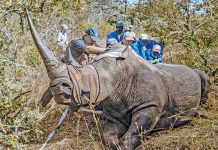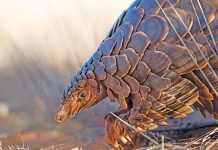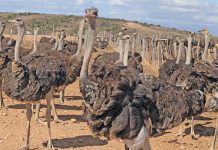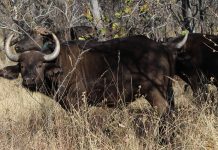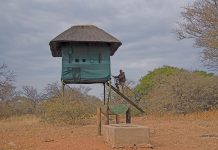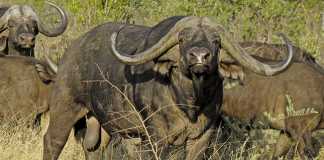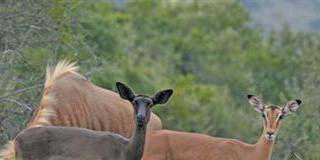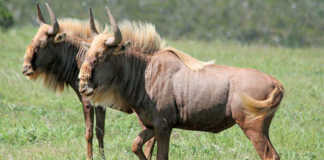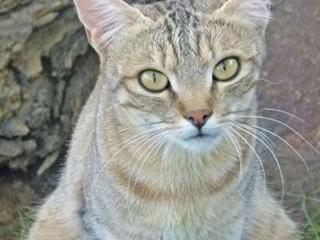
The subcontinent’s smallest wild cat species, the black-footed cat and the African wild cat, occurring naturally in Eastern Cape, are in danger. Secretive and nocturnal, these felids are proving vulnerable, difficult to protect and equally difficult to monitor. Marion Holmes and her husband Richard, of Clifton game farm in the upper Great Fish River valley, manage a captive breeding programme for both species via the Cat Conservation Trust, established in 2004.
“The African wild cat and the black-footed cat are in dire straits as far as I am concerned. They are facing so many challenges it’s frightening,” says Marion. Her involvement in breeding indigenous wild cats began a decade ago after she met German IUCN (International Union for Conservation of Nature) cat specialist, Dr Mircea Pfleiderer, who has monitored cats in the Karoo for three decades and kept a number of them in captivity since the late 1990s.
Based during the African summer on the farm Honingkrantz near Cradock, where she has a number of cat enclosures, Dr Pfleiderer returns to Germany every winter to fulfil academic responsibilities. During her absence, Marion attends to the cats and maintains continuity in their combined breeding and research project. This project aims to boost captive populations worldwide, introduce them into protected areas in South Africa and create awareness of their role in the environment and their plight.
Non-selective predator control
Although Marion agrees that predators are a challenge to farmers under certain circumstances, she explains that the indiscriminate killing of all predators is counter-productive in that it creates a vacuum which is taken up by ‘worse problems’. Non-selective control of problem animals has a devastating effect on non-target species such as the black-footed cat and the wild cat that feed predominantly on rodents, insects and birds.
“I promote a sensible approach to predator control; if you have to kill it [predators such as caracal and jackal], kill it, but weigh up all your options,” she says. According to Marion, the black-footed cat is seriously affected by predator control. “They are caught in gin trips and are scavengers so they will feed on poisoned carcasses and brown locusts sprayed with harmful insecticides. And then there are the dog packs.”
Richard takes up the story and talks of the effect that uncontrolled dog packs have on all animal life they encounter on a hunt. “A dog pack must be professionally handled, not a killing machine sweeping through the veld,’’ he says. ‘’ The dogs must be muzzled and trained to go for target animals.’’
The first black-footed cat Dr Pfleiderer received in 1997 barely survived a dog pack that had killed its mother and siblings. “This was a serious loss considering that the range of a male black-footed cat can be about 20km2,” says Marion. “There are no healthy populations where irresponsible dog hunting takes place. I would say on farms where there is no dog hunting there can be a sound population of black-footed cats which is one or two or three per farm, because they have such big territories,” says Dr Pfleiderer.
Although the African wild cat (from which today’s domestic cats were bred) is vulnerable to many of the same threats, it is the genetic threat of hybridisation with domestic and feral cats (rated among the top 100 worst invasive species by the IUCN Global Invasive Species Programme) that is most worrying.
“We don’t know how many pure wild cats there are – there is such an issue with hybridisation that the wild cats are at an evolutionary dead end,” says Marion. Dr Pfleiderer says the rusty red colour behind its ears and its proportionally longer legs are two important characteristics that set a pure wild cat apart from a hybridised version.
Breeding in captivity
The two women have seven black-footed cats, a significant percentage of the 79 in captivity registered in the black-footed cat studbook held by Germany’s Wuppertal Zoo, and nine genetically pure African wild cats. They have successfully raised 11 black-footed cats and 25 African wild cats and supplied both species to various state and private game reserves, other breeding initiatives in South Africa and zoos in Europe and the US.
A significant feat considering the breeding and raising challenges, especially with black-footed cats. “These cats are vulnerable to feline diseases transmitted by feral cats, acting as disease carriers,” says Marion. She says that certain viral infections seem to strike tiny black-footed kittens (with a mean birth weight of just 78g) particularly hard during the first three months of life. “Immunity from the mother’s milk declines about six weeks after birth and that is when they get sick. We aim to get them to 12 weeks when we can vaccinate.”
Critical to the successful captive breeding and maintenance of these cats is a dry, virus-free environment, says Dr Pfleiderer. “The cats must be kept like cacti; a damp environment is loaded with viruses they are not used to.” Although the Karoo is generally dry, the heavy rains of the past two years have probably been a contributing factor to increased mortality rates among black-footed kittens at Clifton farm. “In the first few years of this project, kitten survival was about 80% but scientists warned of a possible crash,’’ Marion explains. “In the last four years, our kitten survival has been down to 20%.”
Kittens need to learn the patience and the skill to stalk, hunt and ultimately kill prey – all prerequisites for life in the world beyond captivity. Learning opportunities are provided by attracting prey into the enclosures with scattered grain to lure rodents and encourage the presence of other prey species, including insects and small snakes. Guinea pigs, rabbits and chickens are kept in adjacent enclosures to stimulate the cats and offer stalking and even killing opportunities if they venture into the cat enclosure through openings in the wire.
Management and feeding
Enclosures are sealed off to keep the cats in and to protect them from predators. ‘’We have a netting roof for protection against predators such as eagles, owls and monkeys,” says Marion. Inside, the best possible specific and preferred natural environment is created. “In the enclosures I try to mimic what I observe in the veld,”’ says Dr Pfleiderer.
“I co-operate with zoos in terms of how to keep cats.” She explains, for example, that the black-footed cat lives on arid plains and shelters in clumps of grass or bush, hollowed out anthills and springhare burrows during the day, while the African wild cat prefers more densely vegetated areas near water.
Black-footed cat enclosures have specially constructed lairs that are cool in the heat of the day and warm and dry during wet, cold weather. Excess water drains into furrows that both species use as footpaths. The daily feeding of the cats – and the expense of it – represents the most significant challenge to the captive breeding programme. Aiming for as balanced a diet as possible for the cats means no mutton, chevon (goat meat) or beef, says Marion.
“It is too fat for them and has negative physiological effects if there is too much in the diet. They need a lean diet that is mostly game; birds, ostriches, dassies, monkeys, baboons – whatever we can lay our hands on.” One of the best sources of food has been unhatched ostrich chicks from local hatcheries, a resource that has mostly disappeared after the regional ostrich industry was hit by avian influenza.
“We would get 100 to 200 dead ostrich chicks a week; if we get 10 now we are lucky,” Marion admits. They purchase venison off-cuts and organ meat from Clifton farm’s small abattoir. “The cats get lungs, livers, hearts, brains and the feet of animals – a bit of everything,” she says.
Contact Marion Holmes on 082 868 1936, email [email protected] or visit www.predatours.co.za, or www.karoocats.org
Sources: Black-Footed Cat Working Group: visit www.black-footed-cat.wild-cat.org, www.wildcatconservation.org, the Field Guide to Mammals of Southern Africa, by Chris and Tilde Stuart, and Alien & Invasive Animals – a South African Perspective, by Mike Picker and Charles Griffiths.

